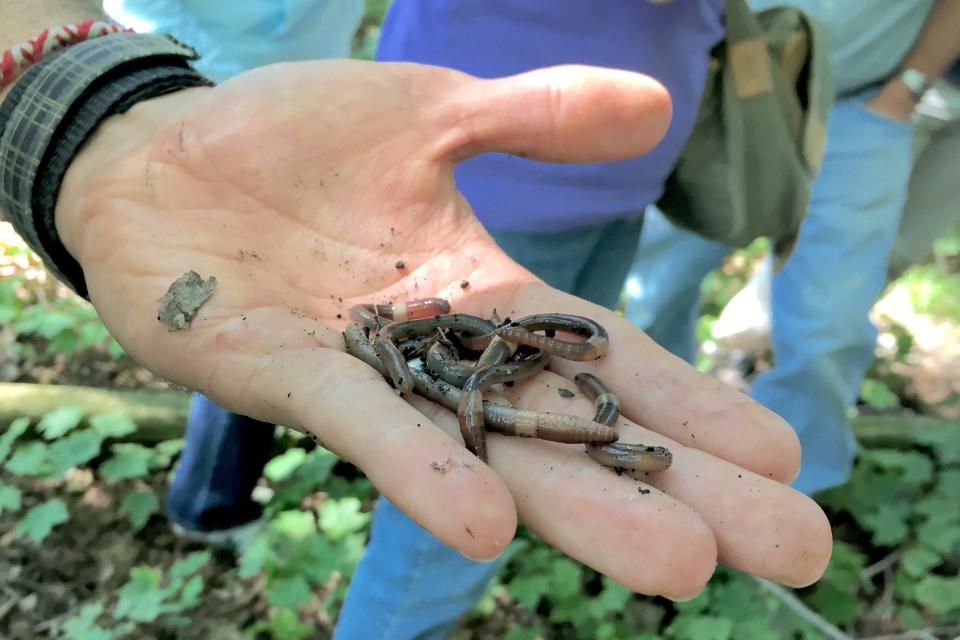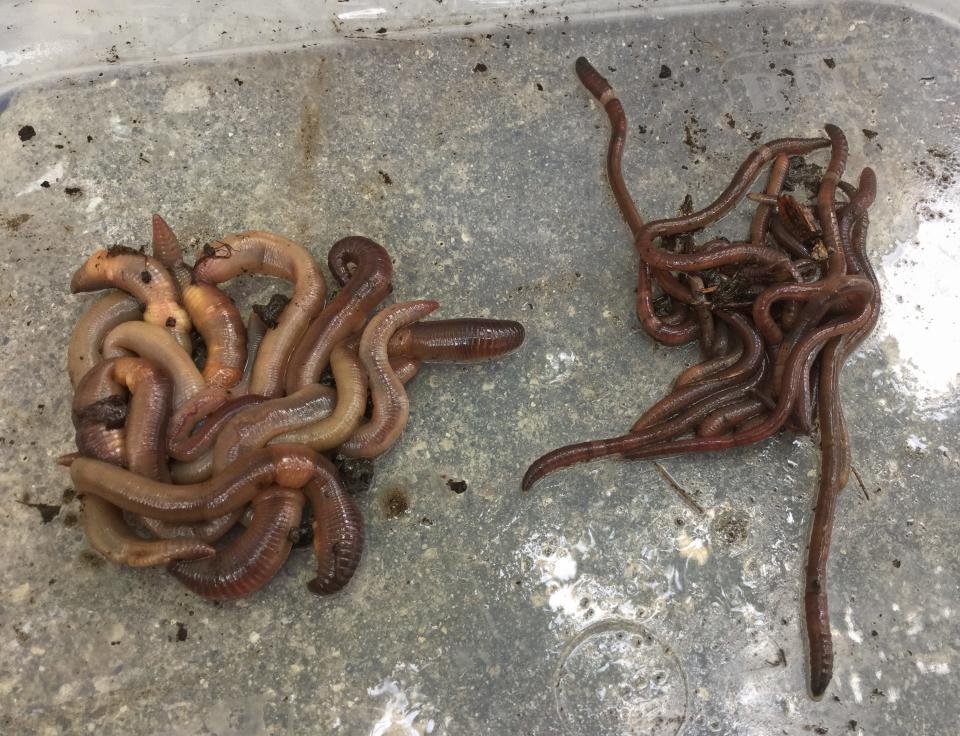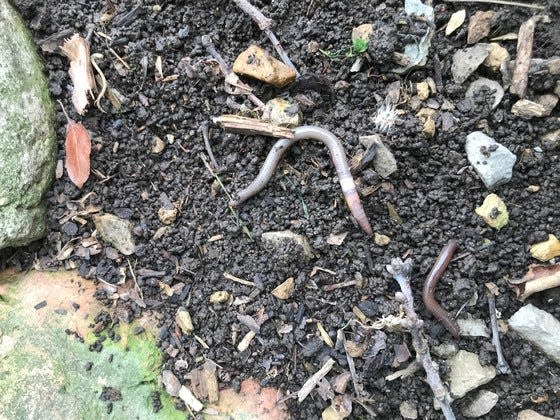Scrub Hub: What are jumping worms? And are they ruining my garden? (They just may be)
Creepy-crawly has an official definition. It’s a noun to describe a small insect, usually flightless, that gives you a feeling of fear or dislike. Spider’s definitely come to mind (especially for me). But for many, something known as a jumping worm hits the nail on the head.
The Asian jumping worm — also sometimes referred to as “Alabama jumpers” or “crazy snake worms” — is an invasive species of earthworm that is moving its way across the Midwest, including Indiana.
Unintentionally, this summer’s Scrub Hubs have been all about creepy-crawlies: Mosquitoes, ticks, lightning bugs (though we wouldn’t consider those scary), fleas and now jumping worms.
What better time, however, as summer is when we are all spending lots of time outside and getting up close and personal with nature — not to mention other creatures and critters.
Though jumping worms may not bite and suck blood the way some of the other subjects featured in Scrub Hub, that doesn’t mean you want them around. The jumping worm may be famous for the thrashing behavior that gives it its name, but it is infamous for the impact it is having on the earth and soils it moves through.

For this edition, we will be answering the question: What are jumping worms? And just how bad are they for your garden? As a little bonus, we’ll also pass along some tips on where to report them and how to potentially keep them at bay.
To find the answers, we looked at the research from experts at Purdue University and other midwestern colleges. Here’s what we learned.
Short answer: Earthworm’s evil twin
Jumping worms are an invasive species, so they are not native to Indiana let alone the United States. They were introduced into the country decades ago, though the precise time is unknown.
They were first recognized as an issue when they were discovered in Great Smokey Mountains National Park. The giveaways: trees not regenerating in the forest as well as areas with little leaf litter and unusual soil.
These worms were then found in the Midwest by the University of Wisconsin at Madison just under a decade ago. Researchers across the region have been tracking their movements since that time.
Scrub Hub: Are lightning bugs disappearing from Indiana's night skies?
So far, the worms have been confirmed in only three counties in Indiana, based on samples sent into the Purdue Plant and Pest Diagnostic Lab: Bartholomew, Vanderburgh and Allen counties. That said, lab officials said the problem is likely much more widespread, but the worms aren’t reported often because Hoosiers aren’t aware of them.
Though both types of earthworms, the Asian jumping worms are very different from the typical worms folks are used to seeing — in more ways than one.
You might be surprised to know that those other worms aren’t native to Indiana and the U.S. either. They were brought over from Europe centuries ago, but these worms do great things for the state’s soils (more on that later).

As for looks, jumping worms can be as small as 2 inches but also grow to 8 inches by the end of the summer — similar to the European worms. The color and the clitellum, or the collar-like ring around the worm near their heads, have more distinctions between the two.
Jumping worms usually are grey-brown in color and have a darker pigmentation since they spend most of their time closer to the surface. Their collar then is milky-white, flat against the body and wraps around the entire worm.
The European worms, on the other hand, have more of a red-brown coloring, though the pigmentation is much less vibrant and can sometimes appear almost translucent. The collar on these worms is more red and it's also raised, or swollen, and doesn’t fully encircle the body — so it’s almost like a saddle.
The biggest difference, however, is their movement.
European worms move slowly and inch forward. Jumping worms, as their name suggests, may noticeably wiggle and jump when disturbed. They can even move across the ground like a snake in an “s” pattern.
Long answer: Wreaking havoc on soils
While these worms may look and move differently, what really matters is the very divergent impacts they have on the soils they call home.
All earthworms are considered ecosystem engineers, changing soil characteristics and contributing to ecosystem shifts. Just some are good changes, and others not as much.
European earthworms are often a gardeners’ or farmers’ best friend. They live deeper down in the soil and their castings — or excrement — are high in nutrients that are great as a garden fertilizer. They look like fresh dirt in small clumps, according to Purdue research. These worms also help to aerate the ground for the plants and their roots.
The diet and castings of jumping worms are very different.
They live their lives within just a few inches of the surface, and rapidly consume nearly all of the organic matter in the topsoil. The castings of the jumping worms do not put the nutrients of the organic matter back into the soil.
Rather, the excrement has been described to be more like coffee grounds or taco meat: It’s small, dry and crumbly.
Those castings decrease the soil quality by removing the organic matter and it also makes the topsoil more likely to be washed and eroded away, according to Purdue research. Plants have a hard time growing and establishing strong root systems in this soil.
The invasive jumping worms reproduce more quickly, grow twice as fast and can infest soils at very high densities. In areas where these worms are heavily infested, other species may start to decline. This includes native plants, soil invertebrates, salamanders, birds and more — it’s like a ripple effect through the environment.
The jumping worms can severely damage the roots of plants in gardens and nurseries as well as forestries and even turf, research from Cornell University found.
Still, there is a lot of research that needs to be done to determine just how extensive jumping worms are across the state and the region. Even more, analysis is ongoing to better understand the potential impacts that these worms already are having or could have on agriculture.
Indiana and much of the Midwest are massive agricultural states, and a pest that damages the super-critical topsoil could prove disastrous.
The Scrub Hub: Your questions. Our answers.
Do you have questions about the environment? IndyStar environmental reporters Sarah Bowman and London Gibson want to hear from you.
Once jumping worms are established, they are hard to eradicate, according to Purdue. There also are no proven tools or approved pesticides for controlling jumping worms at this time. That’s why the best method is to prevent them from taking hold in the first place.
These worms can spread through soil, compost and other organic material. They were believed to have originally spread from being purchased as composting worms and fishing bait.
Ways to reduce the risk of spread is to clean equipment and tires between locations, paying particular attention to large clumps of dirt. It’s also important to clean dirt off boots — Purdue says they only need a little soil to move from one place to the other, especially when in cocoon form.
Scrub Hub: Are ticks across Indiana getting worse? Should Hoosiers be worried?
The university also recommends removing soil from new potted plants that are going to be planted outside, when possible. That can be done by removing the soil from the plants and throwing it in the trash and then repotting it with sterile soil.
Other prevention measures include to check fishing bait before buying it and staying away from those that thrash strongly. Also make sure to check worms bought for composting before putting them in the pile. In both cases, Purdue research says if you're not sure, “don’t risk it.”
If you suspect you have jumping worms, put them in a tightly sealed container and throw them in the trash.

Still, if jumping worms have already been established, a method called solarizing might help to control them. Solarization involves covering the soil with clear plastic during the summer, which helps heat up the soil. The worms, as well as their cocoons, will die if exposed to temperatures above 105 degrees Fahrenheit for at least 30 minutes.
As the state works to better understand the spread of these worms and their impact — as well as how to control them — researchers say they need your help. They want Hoosiers to help track jumping worms to get a clearer picture of where they are located.
If you’ve seen a jumping worm, Purdue recommends taking a picture and reporting it to the GLEDN phone app, EDDMapS, the invasive species line at 1-866-663-9684 or to depp@dnr.IN.gov.
Also, if you aren’t sure if you have jumping worms, feel free to send a sample to Purdue’s Plant and Pest Diagnostic Lab.
If you have more questions about worms, other insects or any other topics, let us know!
You can ask us by submitting a question through our Google form below. Can’t see the form? Click here.
Call IndyStar reporter Sarah Bowman at 317-444-6129 or email at sarah.bowman@indystar.com. Follow her on Twitter and Facebook: @IndyStarSarah. Connect with IndyStar’s environmental reporters: Join The Scrub on Facebook.
IndyStar's environmental reporting project is made possible through the generous support of the nonprofit Nina Mason Pulliam Charitable Trust.
This article originally appeared on Indianapolis Star: Why jumping worms are hurting the soils in Indiana and the Midwest

